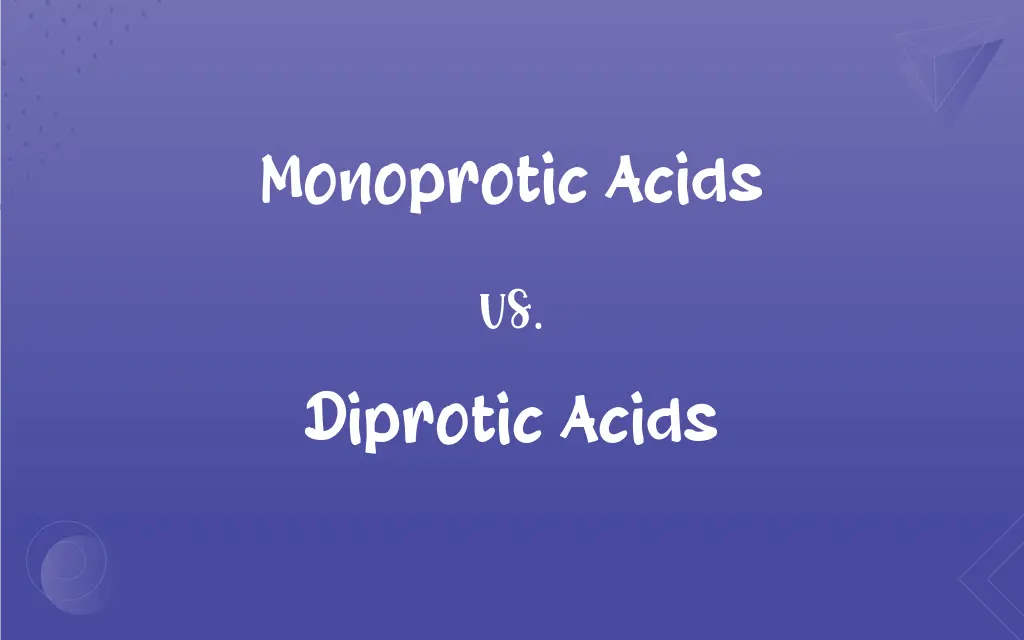Monoprotic Acids vs. Diprotic Acids: What's the Difference?
Edited by Janet White || By Harlon Moss || Published on January 28, 2024
Monoprotic acids donate one hydrogen ion per molecule in solution, while diprotic acids can donate two hydrogen ions per molecule.

Key Differences
Monoprotic acids, such as hydrochloric acid, can donate one proton (H⁺ ion) per molecule in an aqueous solution. Diprotic acids, like sulfuric acid, have the ability to donate two protons per molecule.
In solutions, monoprotic acids typically undergo a single ionization, affecting pH once. Diprotic acids can ionize twice, potentially having a more significant impact on pH with each step.
When titrated, monoprotic acids show one inflection point on a pH curve, corresponding to one ionization step. Diprotic acids display two distinct inflection points, each for one of the two ionization steps.
Common monoprotic acids include acetic acid, used in vinegar. Diprotic acids like carbonic acid play essential roles in geological and biological systems.
Monoprotic acids are simpler in behavior, with one dissociation constant (Ka). Diprotic acids have two dissociation constants (Ka1 and Ka2), indicating different strengths for each ionization step.
ADVERTISEMENT
Comparison Chart
Number of Protons Donated
One hydrogen ion per molecule
Two hydrogen ions per molecule
PH Impact
Affects pH once during ionization
Can affect pH twice, each ionization
Titration Curve
One inflection point
Two inflection points
Common Examples
Hydrochloric acid, acetic acid
Sulfuric acid, carbonic acid
Dissociation Constants
One dissociation constant (Ka)
Two dissociation constants (Ka1, Ka2)
ADVERTISEMENT
Monoprotic Acids and Diprotic Acids Definitions
Monoprotic Acids
Compounds with one equivalence point in a titration curve.
Formic acid, found in ant venom, is an example of a monoprotic acid.
Diprotic Acids
Acids that yield up to two moles of H⁺ ions per mole of acid.
Malonic acid, found in many fruits, is an example of a diprotic acid.
Monoprotic Acids
Substances with a single ionizable hydrogen atom per molecule.
Nitric acid, a strong monoprotic acid, is used in the production of fertilizers.
Diprotic Acids
Acids capable of donating two protons per molecule.
Sulfuric acid is a diprotic acid used in car batteries.
Monoprotic Acids
Acids that donate one proton per molecule in solution.
Hydrochloric acid (HCl) is a monoprotic acid used in laboratories.
Diprotic Acids
Compounds with two equivalence points in titration.
Succinic acid, a diprotic acid, is used in food and beverage industry.
Monoprotic Acids
Acids characterized by one dissociation step in water.
Acetic acid, a weak monoprotic acid, gives vinegar its sour taste.
Diprotic Acids
Substances with two ionizable hydrogen atoms per molecule.
Carbonic acid, a diprotic acid, is found in carbonated beverages.
Monoprotic Acids
Acids that yield one mole of H⁺ ions per mole of acid.
Hydrofluoric acid, used in etching glass, is a monoprotic acid.
Diprotic Acids
Acids characterized by two distinct dissociation steps.
Oxalic acid, a diprotic acid, is used as a cleaning agent.
FAQs
Are all monoprotic acids strong acids?
No, they vary from strong (like HCl) to weak (like acetic acid).
What is a common use of monoprotic acids?
They're used in food, industry, and laboratories.
What defines a monoprotic acid?
It's an acid that donates one proton (H⁺) per molecule.
How is the strength of a monoprotic acid measured?
By its dissociation constant (Ka).
What makes an acid diprotic?
The ability to donate two protons per molecule.
How do diprotic acids behave in titration?
They show two equivalence points, one for each proton.
Can diprotic acids have varied industrial uses?
Yes, they're used in battery manufacturing, food processing, etc.
Can monoprotic acids affect pH significantly?
Yes, depending on their concentration and strength.
What's an example of a weak diprotic acid?
Carbonic acid, found in soft drinks.
Do monoprotic acids have multiple ionization stages?
No, they only ionize once.
Are diprotic acids always stronger than monoprotic acids?
Not necessarily; their strength varies per ionization step.
Can diprotic acids form buffer solutions?
Yes, especially in their first ionization stage.
What's the pH range for strong monoprotic acids?
They typically have a low pH, often below 3.
Can monoprotic acids be naturally occurring?
Yes, examples include citric and acetic acid.
How do diprotic acids contribute to acid rain?
Sulfuric acid, a diprotic acid, is a major component of acid rain.
Is hydrochloric acid a monoprotic or diprotic acid?
Hydrochloric acid is a monoprotic acid.
Do all monoprotic acids have the same dissociation constant?
No, it varies depending on the acid's strength.
What's a unique feature of diprotic acids in titrations?
They have two distinct steps of proton donation.
Are diprotic acids common in biological systems?
Yes, examples include oxalic acid and carbonic acid.
How do the two Ka values of diprotic acids differ?
The first Ka (Ka1) is usually higher than the second (Ka2).
About Author
Written by
Harlon MossHarlon is a seasoned quality moderator and accomplished content writer for Difference Wiki. An alumnus of the prestigious University of California, he earned his degree in Computer Science. Leveraging his academic background, Harlon brings a meticulous and informed perspective to his work, ensuring content accuracy and excellence.
Edited by
Janet WhiteJanet White has been an esteemed writer and blogger for Difference Wiki. Holding a Master's degree in Science and Medical Journalism from the prestigious Boston University, she has consistently demonstrated her expertise and passion for her field. When she's not immersed in her work, Janet relishes her time exercising, delving into a good book, and cherishing moments with friends and family.































































